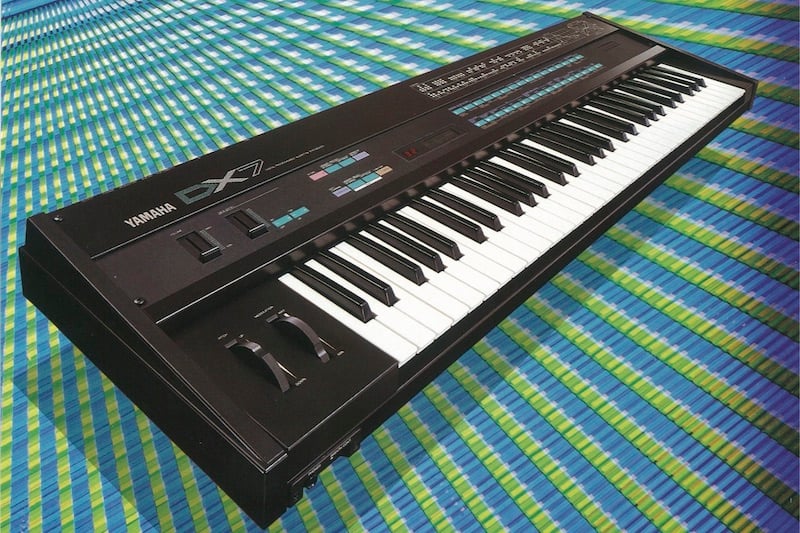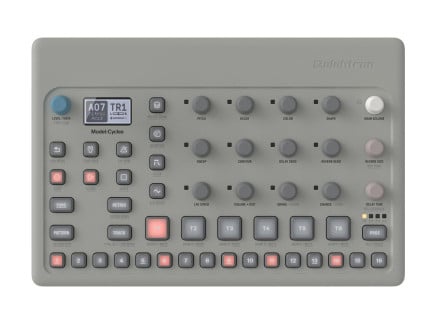Ranked among the best-selling synthesizers of all time, the Yamaha DX7 didn't simply change the course of electronic instrument design—it had a monumental impact on music as a whole. In the early 1980s, analog synths expanded beyond progressive rock bands and early electronic musicians, slowly creeping into pop music studios. But it wasn't until the release of the DX7 that the synthesizer truly became a mainstay instrument in the eyes of most musicians.
While the DX7 is certainly the most iconic member of its family, the entire DX series was a culmination and refinement of over a decade's worth of work between Yamaha and Dr. John Chowning, who discovered the capability and musical implications of FM synthesis at Stanford University in the 1960s. Side note—if you're interested in reading more about Chowning's perspective on FM, Elektron posted an excellent interview with him back in 2018.
Upon its release in 1983, the DX7 was the first digital synthesizer to see widespread usage by many. Compared to early digital instruments like the Synclavier and Fairlight CMI, at the release price of $1995 it was vastly more affordable, and compared to its analog peers released the same year, like Roland's Jupiter-6 and Sequential Circuits' Prophet-600, it offered much more versatility and immediate appeal to the everyday musician.
The Synth Heard Round the World: DX7
Aside from its 61 keys and rectangular shape, the DX7 starkly contrasted in appearance and operation from other synthesizers of the time. Gone were an abundance of knobs, switches, and sliders—all replaced with an array of buttons, a single data entry slider, and a tiny LCD screen for accurate visual feedback. It had an impressive 16-voice polyphony and 32 onboard presets, expandable to 64 with the use of external ROM preset cartridges.
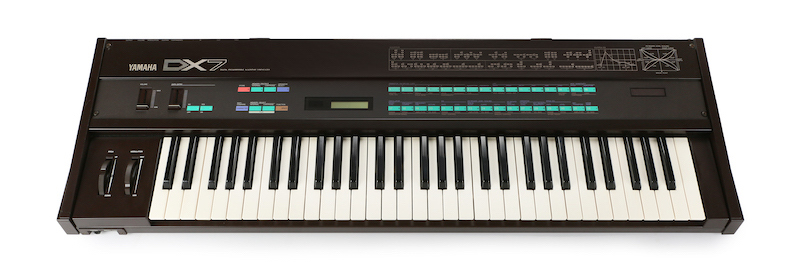
For its sound engine, the DX7 contains six sine-wave operators per voice for sonic sculpting, with 32 different algorithms that rearrange the operators into various configurations for modulating each other. In the realm of FM synthesis, an operator is simply the combination of an oscillator with amplitude controlled by an envelope generator. A single-operator synthesizer would just be a sine wave with a volume control, but synthesizers like the DX7 arrange these operators in different ways to modulate the pitch or phase of other operators, and these configurations play a large role in shaping the final timbre heard when you play a note. This is further expanded upon by using ratio relationships between the base pitches of operators, with integer ratios like 2:1 and 5:1 resulting in pleasing, harmonic consonance, whereas fractional ratios introduce more clashing harmonics with less discernible tonality. Moreover, in many of these instruments, users can also elect for certain operators to work at fixed frequencies regardless of the note played, leading to timbres that vary in stability depending on the exact notes that you play.
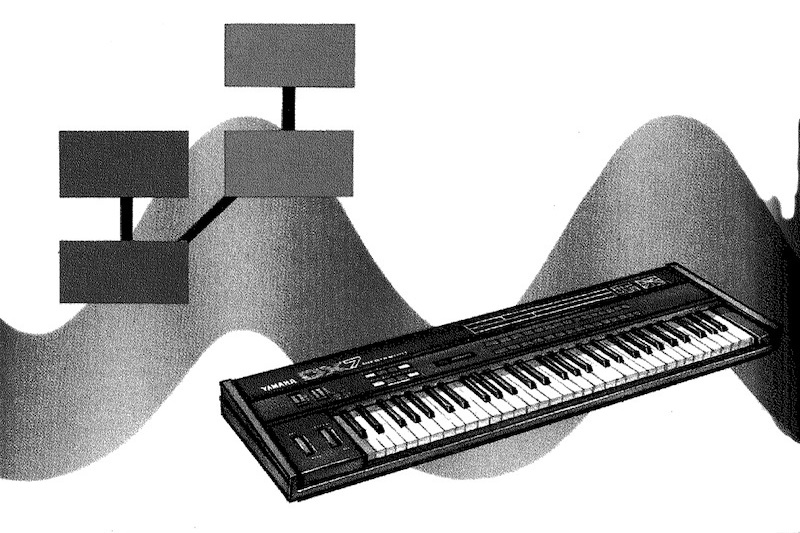
Perhaps not too surprisingly, most who used the DX7 never strayed too far beyond the factory preset sounds, whether built-in to the instrument or through external ROM cartridges. Although the user-interface design choice to use a single slider repurposed by its various buttons was a practical design solution for controlling the enormous number of parameters within the DX7, in reality the unfamiliar territory of FM synthesis and time commitment involved in programming patches left many frustrated. Of course, several particularly determined musicians did take the time to thoroughly learn DX7 programming—one notable example is Brian Eno's 1983 album, Apollo: Atmospheres and Soundtracks, with the DX7 perfectly channelling the themes and emotional weight of outer space exploration. Yamaha seemed to have some amount of foresight into most being overwhelmed by the new paradigm of FM synthesis, and called in brilliant musicians and synthesists David Bristow and Gary Leuenberger to craft the original factory preset sounds—programming most of them in less than a week! Most of the presets were modeled after real instruments, ranging from brass and strings to bells and voice-like pads, with Bristow and Leuenberger relying upon the DX7's velocity and touch capabilities as well as each operator's envelopes to sprinkle magic into not just the onset and duration of sounds, but add sonic contour to the release of notes as well.
Even just relying upon the presets, many who adopted this instrument instantly felt their sonic palette expanding in new directions, and the DX7 was soon taking the place of not only its analog counterparts, but electric pianos, organs, and more, as well. Although many felt that most of the presets did not totally sound like the real instruments they were emulating, the newfound sonic variety prompted many to keep a DX7 handy in their studio to bust out sounds anytime an easy and reliable keyboard was needed. While some deemed the sounds of FM to be "colder" and "thinner" than the previous generation of analog synthesizers, it seemed that these qualities are a large contributing factor to what made the DX7 sit so well in a mix. Add in the incorporation of MIDI features like velocity, and the DX7 became recognized as a playable and expressive instrument by musicians everywhere.
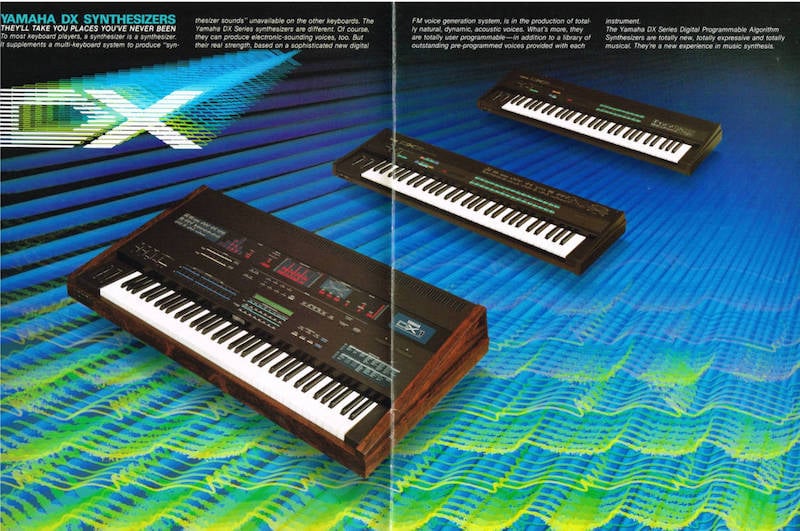 A decidely 80s-style ad for the early DX series
A decidely 80s-style ad for the early DX series
While there are some more substantial variations on the DX theme that we'll get into shortly, it's worth mentioning that there were a few notable revisions to the DX7. The top of the line DX1 was effectively two DX7s in one, but was prohibitively costly for most, and most of its functionality was retained in the later DX5. In 1986, Yamaha released the DX7S and DX7 II, upgrading the output DACs, increasing preset storage, and some additional elements to the sound engine. If you didn't need a keyboard, the TX802 offered the exact same functionality and sound engine in a convenient 2U rack unit.
Four Operators: DX9 / DX21 / DX27 / DX100
Released alongside the DX7, the DX9 featured only four operators and eight algorithms compared to its sibling's six and 32, respectively, and no capacity for the use of external preset ROMs. As such, the reduced sonic capability made it somewhat less desirable than the DX7, but the DX9 was more widely available on release compared to the backlog of orders for the other. While it only contained twenty onboard presets, it did come with a cassette tape (!) containing 120 additional presets. Beyond this, it was exactly the same as the DX7 in form and function, something which could not be said for the later four operator members of the DX family.
Although the DX9 offered most of the original DX7's capabilities, the $1395 retail price was deemed a bit too high in the eyes of many. In 1985, Yamaha attempted to rectify this with the release of a whole new fleet of four operator DX instruments. Though there are a few differences between each of these models, they do share several common threads in functionality. Notably, these instruments feature cheaper chips for the sound engine, only 8 voices of polyphony, and a lack of velocity or aftertouch functionality on the keyboards. While this may make for a lack of immediate expressive capabilities for the player, these omissions largely contribute to this range's sub-1000 price point, and as such, they were some of the most accessibly priced keyboards at the time they were released.
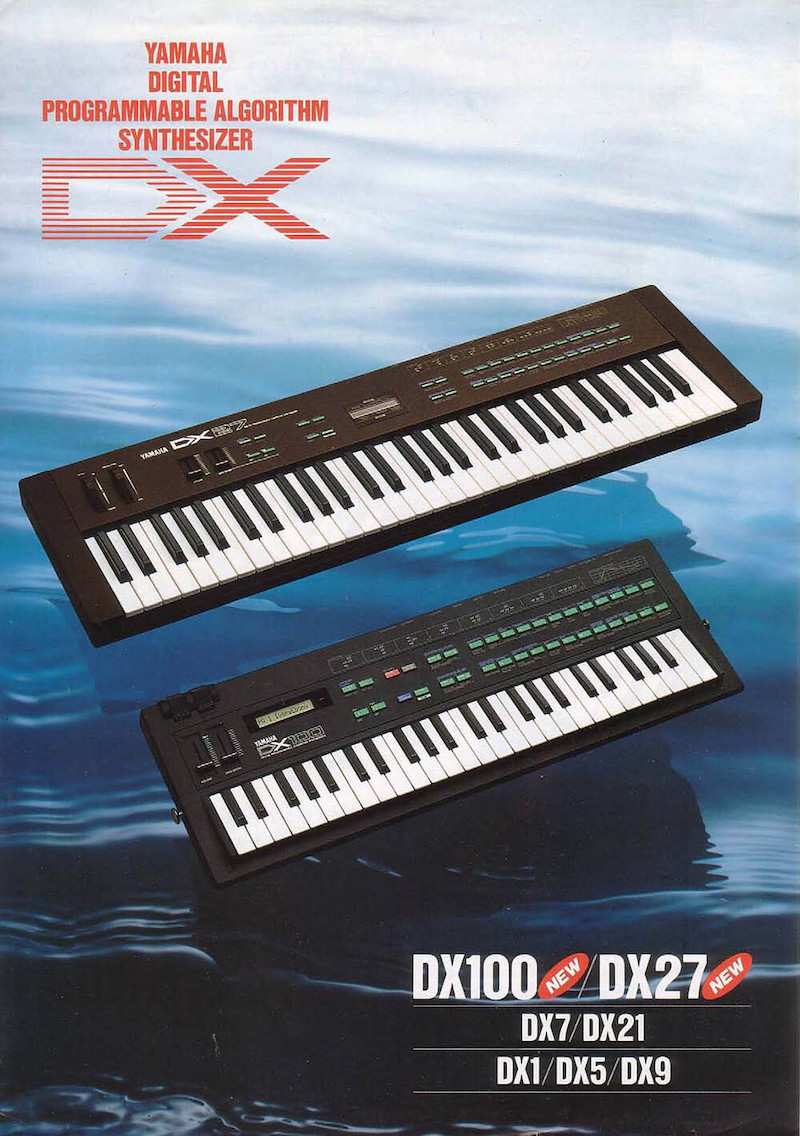
While not as fully featured as the DX7, the DX21 is notable for containing a built-in chorus effect. A common practice in the 1980s, engineers were often throwing chorus onto DX7 tracks to thicken things up and create a wider presence in the mix, so Yamaha's decision to include it in the instrument was a no-brainer. The keyboard also features bi-timbral splitting and layering functionality, offering the appeal of stacking up sounds or loading up a bass patch for the left hand and pads or lead for the right.
The DX27 is nearly the exact same thing as the DX21, but lacks the chorus and the split and layer features. A smaller version of this instrument was also released: the DX100, which utilized mini-keys but otherwise offered the exact same functionality as the DX27 at an incredible $445 on release, making it one of the most fully-featured affordable synthesizers released at that point in time. Don't be fooled by the small size of the DX100 though, it's still a fully capable synth in its own right—it was included in the infamous gear list printed onto the back of Aphex Twin's Syro.
DX11: The Coolest Member in the DX Series?
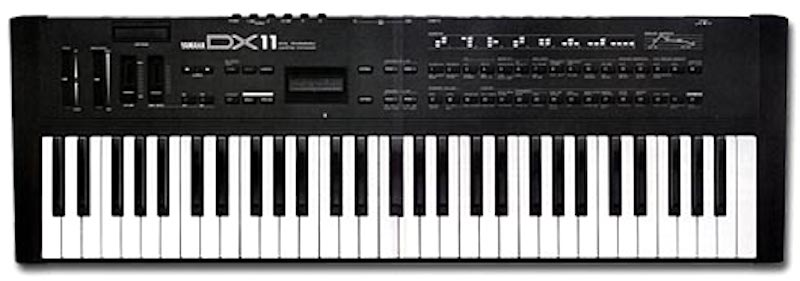
Among the last of Yamaha's instruments to bear the DX name in the 80s, the DX11 is another member of four operator DX line. It's actually a keyboard version of the previously released TX81z, but both of these models offer the distinction of including more than just sine waves for its operators. By allowing the use of other waveforms with richer harmonic content, FM gets pushed into even grittier territory, adopting a totally different character from the comparatively icy, smooth timbres generated from just sine waves. Although clever programming of the prior DX instruments could easily generate rich timbres, using waveforms with more harmonics as base can accelerate the sound design process. Applying FM to an operator that already contains a lot of content yields interactions that can easily get pretty wild, thus the DX11 showed a glimpse of what could be possible with FM synthesis in the future.
While the DX11 is directly incapable of velocity and aftertouch from its keyboard like the prior entries in the four operator series, Yamaha made sure to include some unique features into this model to maintain as much expressive and creative potential as possible. Highlights include micro-tuning capability, a pitch-shifting note delay, and a pseudo-reverb effect that adds a secondary release slope to the envelope generators. It's also eight-part multitimbral, so it's easily possible to layer and split sounds, although it does remain limited to eight-voice maximum polyphony. It's also possible to round-robin between the eight different parts for each successive note played, meaning that you can cycle through an assortment of stabs, plucks, drones, or any assortment of FM textures. Yamaha additionally included some quick edit functionality to facilitate easier on-the-fly control of parameters on a global level, like the attack and release stages of all envelope generators.
FM Synthesis Beyond the DX7
Although the end of the 1980s marked the effective end of the DX family and the FM hype, advances in technology and additional synthesis techniques have kept FM a viable method of synthesis into the present day, with many manufacturers across the years trying their hand at creating FM-based instruments with a greater ease of programming than found in Yamaha's original devices. Yamaha themselves have honored the legacy of the original DX instruments with the Reface DX, revamping the four operator engine used on the DX9 and others for the modern day, but adding in a bigger screen and a few other additions to smooth out the patch creation process, as well as some effects and a built-in MIDI looper to make it a more complete instrument.
In the past few years, Elektron's Digitone has perhaps single-handedly brought the appeal of FM back into the forefront for many performing electronic musicians. Its combination of FM and subtractive synthesis methods combined with Elektron's tried and true sequencing capabilities make for a total powerhouse of an instrument. On the other hand, if you're looking for a no-frills, percussion-oriented approach to FM, their streamlined Model:Cycles groovebox shows that FM is capable of more than just glassy pads and punchy basses.
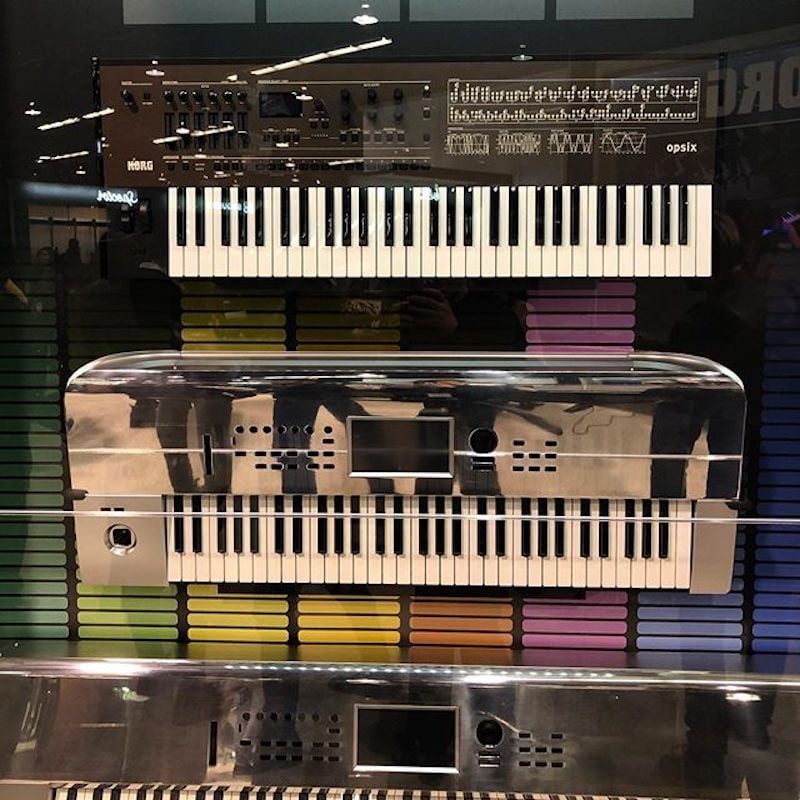 Korg Opsix concept at NAMM 2020
Korg Opsix concept at NAMM 2020
Among the most popular members of Korg's Volca series of portable instruments is the fittingly named Volca FM. While it has certainly taken some visual cues from the DX7 in its color palette, it actually contains the same six operator architecture and 32 algorithms as the original, and can even load up SYS-EX messages for DX7 presets. It does only have three voices of polyphony, but the inclusion of built-in chorus and a killer sequencer make it a serious instrument in its own right. Korg also revealed a concept synthesizer named Opsix at NAMM earlier this year, bearing remarkable resemblance to an actual DX7. The instrument was shown in a glass case and not available to be played by the public, but the fact that it was even displayed at all seems to hint that Korg might be cooking up an exciting new FM instrument.
Following in the footsteps of the original DX7's goal to be a highly playable and expressive instrument at the hands of a musician, Kodamo's Essence FM offers a clear, touch-screen interface to easily arrange operators and modify envelopes. Essence FM boasts an impressive 300-voice polyphony, allowing a generous capability for splitting and layering distinct timbres. It also supports MPE controllers, offering superb polyphonic control capabilities on a per-note basis.
Want FM in your modular setup? ALM's Akemie's Castle actually utilizes NOS Yamaha ICs and sonically delivers similar waveforms as the DX11, with the distinct advantage of voltage control. Meanwhile, a more modern approach can be found in Humble Audio's (now-discontinued) Quad Operator, eschewing the traditional algorithm format in favor of a modulation matrix allowing for any and all combinations of its four operators, with a design that Humble Audio states is inspired by the open algorithm architecture of Native Instruments' FM8. Check out our video with Will from Humble Audio for an in-depth look at this clever approach to FM in Eurorack format.
The DX7 and its family of instruments shook the music world to its core, becoming a defining component of the sound of popular music in the 1980s. Because so many DX7s were produced, even today they remain a fairly affordable choice on the vintage market, and even more so for the rackmount modules or less popular four operator models. In any case, any of the DX instruments are an instant way to get that authentically 80s FM vibe, and with some dedication to learn the quirks of its programming interface, a whole wealth of sound awaits to be explored.

